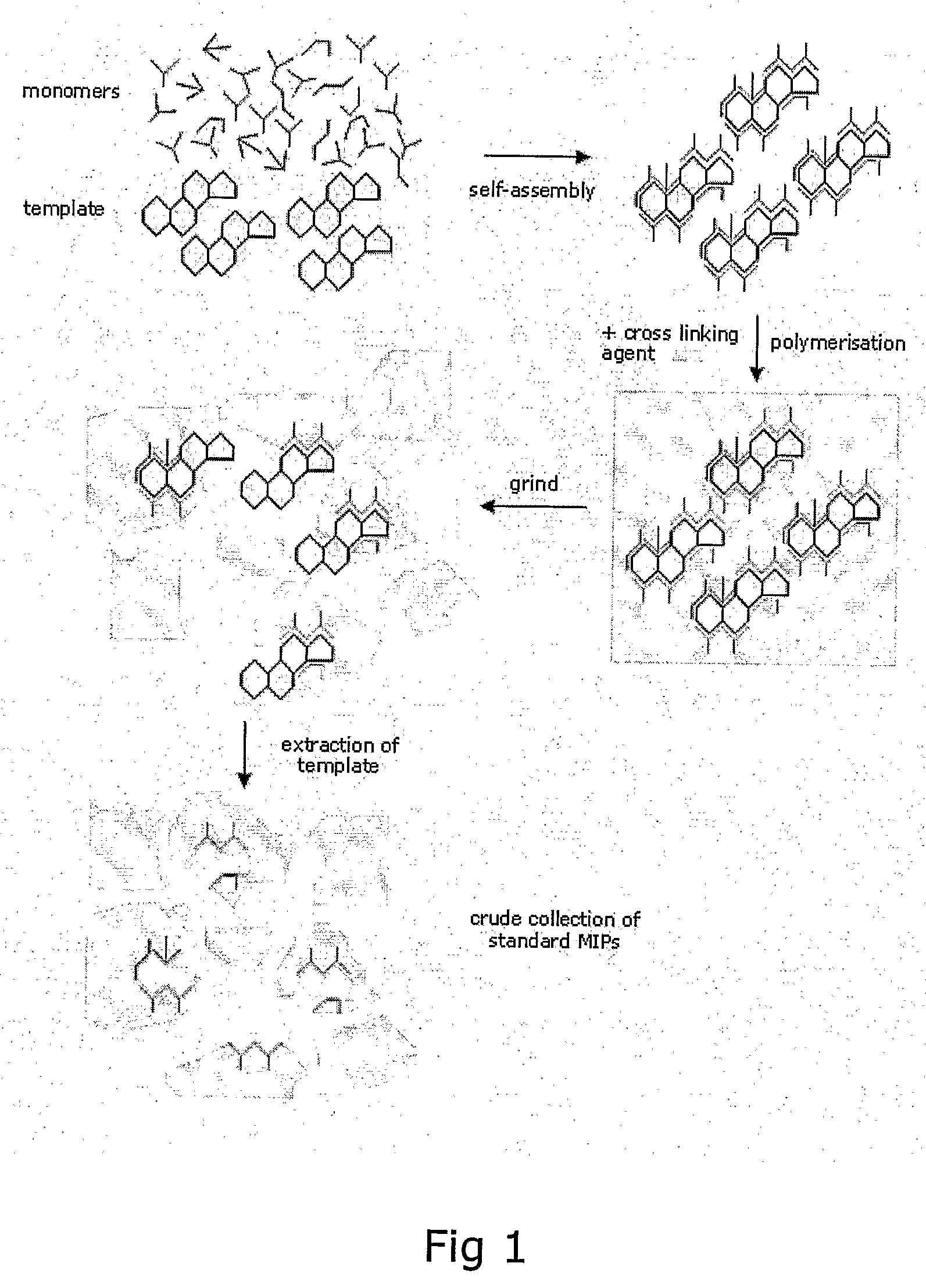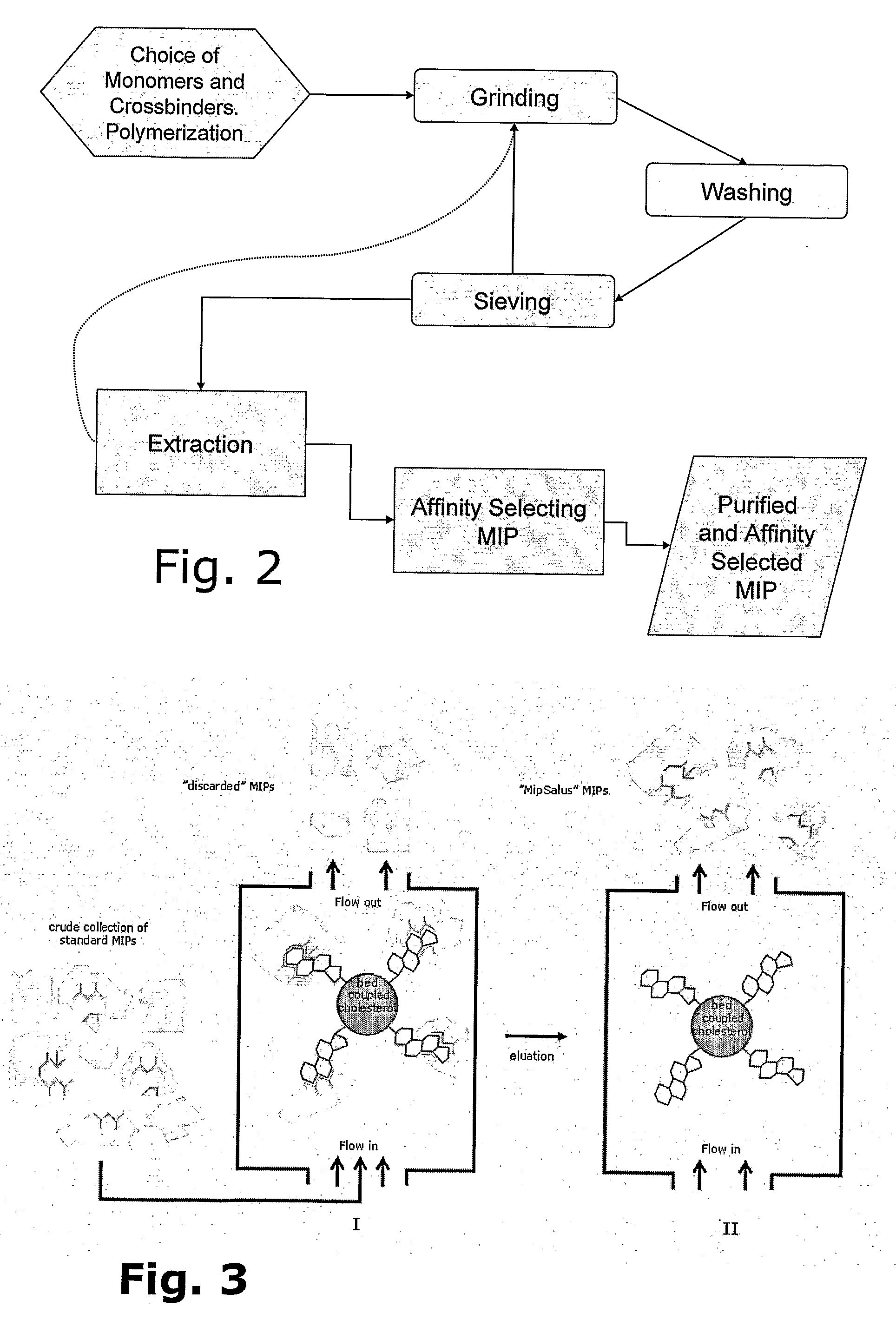Preparation of Molecular Imprinted Polymers
a technology of imprinted polymers and polymers, which is applied in the field of improvement in the preparation of molecular imprinted polymers, can solve the problems of inability to achieve the effect of mips, inability to achieve the effect of soluble receptors and antibodies, and low overall binding capacity, and achieves the effect of high binding capacity
- Summary
- Abstract
- Description
- Claims
- Application Information
AI Technical Summary
Benefits of technology
Problems solved by technology
Method used
Image
Examples
example 1
MIP with Fluorescein as Template
[0168]In a 100 mL flask 1.4 ml of the monomer methacrylic acid (MAA), 9.5 ml ethyleneglycoldimethacrylic acid (EGDMA), 50 mg fluorescein and 10 ml tetrahydrofuran (THF) is mixed on a hot water bath (approx. 40° C.) for 30 min. 2 g of 1,1-azobis(cyclohexane-carbonitrile) (ACHCN) is added slowly. After dissolution the solution is purged with Ar (THF sat'd) for 15 min. The polymerization is initiated by continuous UV light (365 nm, 9W) for 48 hours. The resulting polymer is yellowish crisp and is micronized in a manual mortar to particle sizes between 10 μm and 25 μm. The powder is refluxed in THF for 30 min and washed and filtered several times in ethanol / THF (75:25). The white powder is left to air dry.
example 2
MIP with Cholic Acid as Template
[0169]In a 100 mL flask 1.4 ml of the monomer methacrylic acid (MAA) 9.5 ml ethyleneglycoldimethacrylic acid (EGDMA), 2 g of cholic acid and 12 mL tetrahydrofuran (THF) is mixed on a hot water bath for 30 min. 0.2 g of 2,2′-azobisisobutyronirtile / 2,2′-azobis(2-methylpropionitrile) (AIBN) is added slowly. After dissolution the solution is purged with Ar for 15 min. The polymerization is initiated by continuous UV light (365 nm, 9W) for 24 hours on an ice bath. The resulting polymer is yellowish, hard and is micronized in a manual mortar to particle sizes between 25 μm and 50 μm. The powder is refluxed in THF for 30 min (once) and washed and filtered four times in ethanol / THF (75:25). The off-white powder is left to air dry over night.
example 3
MIP with Cholic Acid as Template
[0170]In a 100 ml flask 2.8 ml of the monomer 2-(dimethylamino)-ethylmethacrylic acid (DMA-EMAA) 9.5 ml ethyleneglycoldimethacrylic acid (EGDMA), 2 g of cholic acid and 12 ml tetrahydrofuran (THF) is mixed on a hot water bath for 30 min. 0.8 g of 2,2′-azobisisobutyronirtile / 2,2′-azobis(2-methylpropionitrile) (AIBN) is added slowly. After dissolution the solution is purged with Ar for 15 min. The polymerization is initiated by continuous UV light (365 nm, 9W) for 24 hours on an ice bath. The resulting polymer is off-white, crisp and is micronized in a manual mortar to particle sizes between 10 μm and 25 μm. The powder is refluxed twice in THF for 30-60 min and washed and filtered three times in ethanol / THF (75:25). The white powder is left to air dry over night.
PUM
| Property | Measurement | Unit |
|---|---|---|
| Length | aaaaa | aaaaa |
| Diameter | aaaaa | aaaaa |
| Mass flow rate | aaaaa | aaaaa |
Abstract
Description
Claims
Application Information
 Login to View More
Login to View More - R&D
- Intellectual Property
- Life Sciences
- Materials
- Tech Scout
- Unparalleled Data Quality
- Higher Quality Content
- 60% Fewer Hallucinations
Browse by: Latest US Patents, China's latest patents, Technical Efficacy Thesaurus, Application Domain, Technology Topic, Popular Technical Reports.
© 2025 PatSnap. All rights reserved.Legal|Privacy policy|Modern Slavery Act Transparency Statement|Sitemap|About US| Contact US: help@patsnap.com



